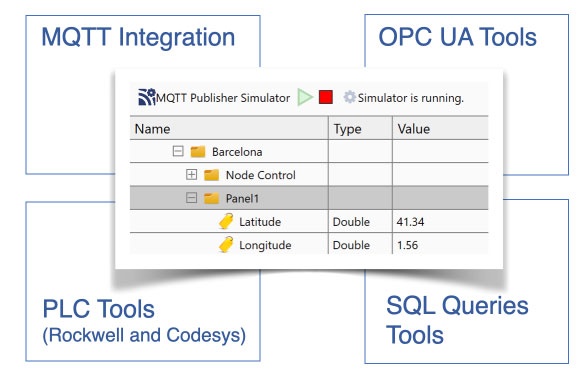P1:Unified Namespace (
Concept) is the first pillar on the Four Pillars methodology, it provides a centralized real-time data repository with hierarchical organization for all solution data.
As the first pillar in the Four-Pillar methodology, it creates a standardized method for accessing and managing tags, assets, and external data sources
.
On this
page:
Table of Contents maxLevel 2 minLevel 2 indent 10px exclude
Steps style none
Key Concepts
Tag:| Concept | Description | Example |
|---|---|---|
| Tag | Process variable representing real-time and historical data |
| Tank01.Level, Pump01.Status | |
| Asset Tree |
| Hierarchical representation of solution data |
| /Plant/Area1/Line1/Equipment | |
| UserType (UDT) |
| Reusable data structure |
| with variables and references |
| Motor template with Speed, Current, Status | ||
| TagProvider Services | Direct interaction with variables in remote systems | OPC UA server, MQTT broker connections |
| Enumeration |
| Named integer values |
| with |
| messages and colors | 0=Stopped, 1=Running, 2=Fault |
| Runtime Database |
| In-memory real-time database managing UNS data | TServer.exe process |
What the UNS Does
The Unified Namespace
data during solution executionserves as your solution's data backbone:
| Data Organization | System Integration |
|---|---|
|
What It Does
Creates and manages
|
|
|
|
|
|
|
|
Configuration Workflow
| Step | Action |
|---|
| Tool (Designer UI) | Tools |
|---|---|
| 1. Define UserTypes | Create reusable structures |
| UNS → UserTypes | Template Editor |
| 2. Build Asset Tree | Organize hierarchy |
| UNS → Asset Tree | Asset Browser |
| 3. Create Tags | Define variables |
| UNS → Tags | Tag Editor, DataExplorer |
| 4. Configure Enumerations | Set discrete values |
| UNS → Enumerations | Enumeration Editor |
| 5. Add TagProvider Services |
| Connect external data | UNS → TagProvider Services | TagProvider Services | |
| 6. Map Remote Data | Link to |
| Asset folders | UNS → Asset Tree | Asset Mapping |
| Info | ||
|---|---|---|
| ||
The DataExplorer tool streamlines UNS creation by enabling:
This tool reduces manual configuration time by 50-70% when building your tag structure during the Foundation phase. → Learn more in the DataExplorer How-to Guide |
Runtime Behavior
Data Loading and Management
When solution execution starts, the Unified Namespace definition loads into the in-memory real-time database (TServer.exe process). This database enables event-driven data exchange between all solution modules with millisecond precision.
Data Access Methods
Modules access Unified Namespace variables through two primary methods:
| Direct Tag Access (Local Tags) | Asset Method Access: Using the Asset() function |
|---|---|
Using tag names |
|
When connecting the tag with the field device
|
|
Tag vs TagProvider Connections
| Aspect | Tags | TagProvider Connections |
|---|---|---|
| Definition | Local real-time variables within solution | Direct link to external system variables |
| Creation | Created and configured locally | Defined in remote system, linked dynamically |
| Data Mapping | Devices Module handles remote mapping | No local mapping required |
| Access Method | TagName or AssetPath | AssetPath only via Asset() method |
| Use Case | Core solution data requiring local control | Dynamic external data without local overhead |
TagProvider TagDiscovery Service
|
Features Highlights
Advanced Data Types
- SQL-compatible types
- - Full
- database data
- type support
- .NET
- entities
- - Images, JSON
- , DataTables in single tags
- Dynamic structures
- - Tri-dimensional arrays, lists,
- collections
- Type-safe references
- - Dynamic tag assignments with
- validation
Hierarchical Organization
- Asset folders
- - Logical grouping matching
- equipment
- Nested templates
- - Composition and inheritance support
- Reusable components
- - Template-based design
- patterns
- Clear data paths
- - Intuitive navigation through
- hierarchy
External System Integration
- Protocol support
- - ControlLogix, OPC-UA, MQTT SparkPlugB
- Database connectivity
- - SQL
- , CanaryLabs, InfluxDB, OSIsoft PI
- Remote applications
- - Other FrameworX solutions
- Dynamic browsing
- - Real-time discovery of
- data structures
Real-time Performance
- Event-driven updates
- - Millisecond timestamp precision
- In-memory database
- - High-performance data access
- Publish-subscribe model
- - Efficient module communication
- Store-and-forward
- - Reliable
- handling during disconnections
Common Implementation Patterns
ISA-95 Model Implementation
| evel | Asset Structure | Typical Tags |
|---|---|---|
| Enterprise | /Company | KPIs, Financial metrics |
| Site | /Company/Site1 | Production totals, Energy usage |
| Area | /Company/Site1/Area1 | Area production, Quality metrics |
| Line | /Company/Site1/Area1/Line1 | Line speed, Product counts |
| Cell | /Company/Site1/Area1/Line1/Cell1 | Equipment status, Process values |
Naming Convention Best Practices
| Code Block | ||
|---|---|---|
| ||
Standard Format: [Area]_[Equipment]_[Component]_[Signal]
Examples:
WTP_PUMP01_MOTOR_RUNNING
WTP_PUMP01_MOTOR_SPEED_SP
WTP_TANK01_LEVEL_PV
BLDG_HVAC_AHU01_TEMP_SP
if using UDT SP is BLDG_HVAC_AHU01_TEMP.SP |
| Code Block | ||
|---|---|---|
| ||
Standard Format: [Area]/[Equipment]/[Component][Signal].[Attribute]
Examples:
WTP/PUMP01/MOTOR/RUNNING
WTP/PUMP01/MOTOR/SPEED.SP
WTP/TANK01/LEVEL.PV
BLDG/HVAC/AHU01/TEMP.SP |
| Code Block | ||
|---|---|---|
| ||
Standard Format: [Area]/[Equipment]/[ComponentUDT].[Signal]
Examples:
WTP/PUMP01/MOTOR.RUNNING
WTP/PUMP01/MOTOR.SPEED.SP
WTP/TANK01/LEVEL.PV
BLDG/HVAC/AHU01.TEMP.SP |
Development Efficiency Tools
- Bulk operations
- - Import/export via Excel, CSV
- Search and filter
- - Quick tag location and editing
- Template
- library - Reusable component repository
- Cross-reference - Find tag usage across modules
- Version tracking - Built-in change management
| Info |
|---|
|
Next Steps
- [UNS (How-to Guide)] - Step-by-step configuration
- [UNS (Reference)] - Complete technical documentation
- [P2: Process Modules] - Connect to field devices
In this section...
| Page Tree | ||||
|---|---|---|---|---|
|

